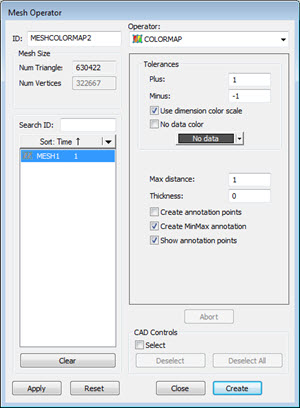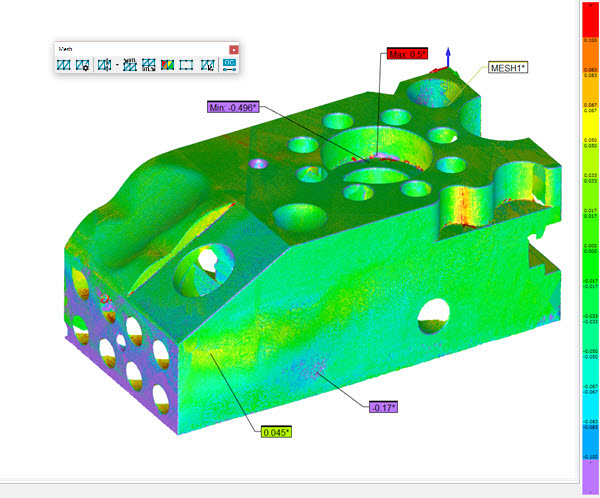

Mesh Operator dialog box - Colormap operator
The Mesh COLORMAP operation applies a colored shading to the selected mesh. The software shades the colormap according to the deviations of the mesh compared to CAD. PC-DMIS uses the colors defined in the Edit Dimension Colors dialog box and the tolerance limits specified in the Upper tolerance and Lower tolerance boxes discussed below.
Because the Mesh colormap shows the color deviations
on the Mesh object, when you apply the colormap, the software hides the
CAD model. By comparison, the Pointcloud colormap colors the deviations
on the CAD model, and PC-DMIS does not hide the CAD model. To show or
hide the CAD model, click the Show CAD button
( )
on the Graphic Items toolbar. For details, see
"Graphic
Items Toolbar" in the "Using
Toolbars" chapter in the PC-DMIS Core documentation.
)
on the Graphic Items toolbar. For details, see
"Graphic
Items Toolbar" in the "Using
Toolbars" chapter in the PC-DMIS Core documentation.
The colors that PC-DMIS uses for the colormap come from the Edit Dimension Colors dialog box (Edit | Graphic Display Window | Dimension Colors).
Select View | Other Windows | Dimension Colors to view the color scale from the Dimension Colors Bar.
Show / Hide Colormaps
You can show or hide colormaps in the Graphic Display window in different ways. When hidden, PC-DMIS does not show the colormaps in the Graphic Display window as you move through the Edit window.
The Activate Colormap button
has two states: Enabled and Disabled. From the Graphics
Items toolbar or from the menu (Operation |
Graphic Display Window | Graphic Items | Activate Colormaps), click
the Activate Colormaps button ( ) so it's in the enabled
state (
) so it's in the enabled
state ( ). PC-DMIS now actively shows colormaps in the
Graphic Display window.
). PC-DMIS now actively shows colormaps in the
Graphic Display window.
To hide the colormaps in the Graphic Display window,
click the Activate Colormaps button again so
it's in the disabled state ( ).
You can also select None from the Colormaps
list to disable colormaps.
).
You can also select None from the Colormaps
list to disable colormaps.
To show the colormaps:
Click the Activate Colormaps button so it's in the enabled state. When you enable this button, PC-DMIS displays the colormaps in the Graphic Display window based on the cursor position in the Edit window.
Select a colormap from the Colormaps list.
When you apply or execute a colormap, PC-DMIS automatically sets the Activate Colormaps button to the enabled state.
When the cursor is on a Mesh, Point, Surface or Thickness colormap in the Edit window, the active colormap appears in the Graphic Display window. PC-DMIS also displays the Colormap ID in the Colormap combo box.
If your cursor is above all the colormaps in the Edit window, PC-DMIS does not show any colormap in the Graphic Display window, and sets the Colormap combo box to None.
To apply the Mesh COLORMAP operation to a Mesh:
From the Mesh toolbar
(View | Toolbars | Mesh), click the Color a Mesh button ( ),
or from the menu, select Insert | Mesh | Colormap.
),
or from the menu, select Insert | Mesh | Colormap.
Update these options based on your needs:
Tolerances - Use this option to set the upper (Plus) and lower (Minus) tolerance values.
Use dimension color scale check box - Select this check box to use the Dimension Colors Bar to define the color bar used for the Mesh Colormap color properties. For details, see "Using the Dimension Colors Window (Dimension Colors Bar)" in the "Using Other Windows, Editors, and Tools" chapter of the PC-DMIS Core documentation.

Edit Color Scale - If you do not select the Use
dimension color scale check box, the software enables the Edit Color Scale button. When you click this button,
the functionality to dynamically change the color, scale and threshold
of the surface and point colormap properties becomes available through
the Color Scale Editor dialog box. For details,
see the "Edit the Color Scale"
topic.
No data color check box - When you select this check box, the software maps the selected color to areas on the selected surfaces where no data is found.
Max distance - The software only includes points that fall within the Max distance value as part of the colormap. Note that if this value is too small, you may not see all the expected colored deviations. A good rule of thumb is to set this value slightly larger (10%, for example) than the largest deviation.
Thickness - This adds a thickness value to deviations on the colormap. This is useful if you want to add a material thickness to the Mesh surface model.
Create annotation points check box - Annotations are a way to display the deviation for a specific location on a surface colormap with its associated color. To create an annotation:
Select the Create annotation points check box. This clears the Select check box in the CAD Controls area and disables most of the options on the right side of the dialog box.
Select a point on the colormapped Mesh in the Graphic Display window. PC-DMIS evaluates and creates an annotation label in the same background color as the Mesh deviation point with the deviation value. You can move the label around in the Graphic Display window as any other label.
Once you create annotation labels, they remain in the same position and have the same characteristics when you restart the measurement routine, or if you restart PC-DMIS and reload the same measurement routine.
Create MinMax annotations check box - When you select this check box, PC-DMIS creates the minimum and maximum values in the form of annotation labels for the active Mesh Surface Colormap.

Example of mesh colormap with min, max, and various point annotation labels displayed
The software calculates the minimum and maximum points each time you execute the measurement routine.
To show, hide, or delete annotation labels, right-click on a label to display the shortcut menu, and then select the appropriate option.
Delete Annotation - The software deletes the selected annotation label.
Show All Annotations - The software displays all annotation labels.
Hide All Annotations - The software hides all annotation labels.
Delete All Annotations - The software deletes all annotation labels.
Show annotation points check box - When you select this check box, the software displays all annotation points.
Click Create to insert a MESH/OPER,COLORMAP command into the Edit window.
For example:
MESHCOLORMAP1=MESH/OPER,COLORMAP,PLUS TOLERANCE=0.5,MINUS TOLERANCE=-0.5,THICKNESS=0,MAX DISTANCE=1,
REFINE FACTOR=0.1,TRIANGLES=401063,VERTICES=206625,
REF,MESH1,,
Colormaps in the Report
For information on how the software shows colormaps in the report, see "Colormaps and the CadReportObject" in the "Reporting Measurement Results" chapter of the PC-DMIS Core documentation.
More: